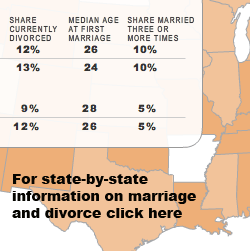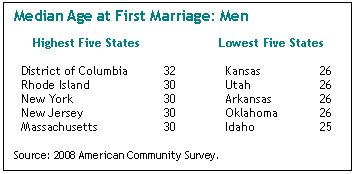In Arkansas and Oklahoma, men and women marry young — half of first-time brides in these states were 24 or younger on their wedding day. These states also have above-average shares of women who divorced in 2007-2008.1
 It’s the opposite state of affairs in Massachusetts and New York. Their residents marry late — half of ever-married New York men were older than 30 when they first wed. These states also have below-average shares of men and women who divorced in 2007-2008.
It’s the opposite state of affairs in Massachusetts and New York. Their residents marry late — half of ever-married New York men were older than 30 when they first wed. These states also have below-average shares of men and women who divorced in 2007-2008.
Remember the classic country song: “All My Exs Live in Texas”? Well, George Strait was on to something. Looking at numbers, Texas is indeed home to more thrice-married adults than any other state, about 428,000 women and 373,000 men. But that’s partly because it’s home to so many people, period. Looking at rates, about 6% of Texans who ever have been married have wed three times or more. That is similar to the national average (5%), but well below the leaders in this category — the neighboring states of Arkansas and Oklahoma — where about 10% of all ever-married adults have had at least three spouses.
Meantime, back in New York and Massachusetts, just 2% of ever-married adults have been married at least three times, placing them at the bottom on this measure among the 50 states.
These findings are drawn from the recently released 2008 American Community Survey, which offers the most detailed portrait yet from the U.S. Census Bureau of marriage and divorce statistics at the state level. This is the first time the survey has included estimates of marriage and divorces within the previous 12 months, duration of marriages and Americans married multiple times.
National Picture
On the national level, the Census Bureau survey showed that a shrinking share of Americans are married2 — 52% of males ages 15 and older and 48% of females ages 15 and older. The proportion of Americans who are currently married has been diminishing for decades and is lower than it has been in at least half a century. The age range used in standard Census tabulations dates back to the days when more people married as young teenagers. Among Americans 18 and older, the proportion currently married, but not separated, is 55% for men and 50% for women.
 Nationally, the median age at first marriage has been climbing for decades: It now stands at 28 for men and 26 for women, meaning that half are younger and half are older when they wed. Among married Americans, the median duration of their married life in 2008 was 18 years. Among men, 9% are divorced; among women, 12% are.
Nationally, the median age at first marriage has been climbing for decades: It now stands at 28 for men and 26 for women, meaning that half are younger and half are older when they wed. Among married Americans, the median duration of their married life in 2008 was 18 years. Among men, 9% are divorced; among women, 12% are.
About 2.3 million men reported that they wed within the previous year, and 1.2 million said they divorced. About 2.2 million women said they wed and 1.3 million said they divorced. About one-in-twenty Americans who ever have been married said they had been married three or more times. That comes to 4 million men and 4.5 million women.
State Highs and Lows
When states are ranked on a variety of estimates, most are clustered closely near the median or average. But the range of values can vary widely, and some of the same states stand out as high or low in more than one category.
Several states in the Midwest and Mountain regions have among the highest shares of men and women who are currently married. In Idaho, 58% of men and 56% of women live with a spouse. In Iowa, 56% of men and 53% of women do. In Utah, 56% of both men and women are currently married. At the opposite end, only 47% of men in Alaska are currently married, as are 48% of women in that state. Among men in Rhode Island and New Mexico, 48% are married. Among women in Rhode Island and New York, 43% are.
The District of Columbia ranks well below all states in its share of men and women currently married — 28% and 23%. Washington, D.C., is more like a city than a state in its characteristics, so it may not be appropriate to compare it with the 50 states.
Looking at divorced adults, 13% of Nevada’s men and 16% of its women fit in that category, as do 12% of Maine’s men and 15% of its women. They are among the states with the largest shares of currently divorced residents, a distinction they share with Oklahoma.
States with larger shares of the thrice-married tend to be states where people marry young, such as Arkansas and Oklahoma. However, one exception is Utah, which does not rank high for three-plus marriages, but whose residents have among the youngest median ages at first marriage: 24 for women and 26 for men.
 Half the men in the District of Columbia, New York and Rhode Island are 30 years of age or older when they first marry. Half the women in Connecticut, Massachusetts and the District are 28 or older. These states rank low in the proportion of people who are married and also in the proportion of married adults who are on at least their third marriage.
Half the men in the District of Columbia, New York and Rhode Island are 30 years of age or older when they first marry. Half the women in Connecticut, Massachusetts and the District are 28 or older. These states rank low in the proportion of people who are married and also in the proportion of married adults who are on at least their third marriage.
States where people marry young also often have high rates of recent marriage, which is expressed as the number of marriages per 1,000 men or women within the previous 12 months. States with high rates of recent marriage include Utah (28 marriages per 1,000 women and nearly the same for men), Idaho and Arkansas. Alaska also ranks high on this measure.
A similar measure — number of divorces within the previous 12 months per 1,000 women — tends to be high in states where women marry young, such as Oklahoma and Idaho. But the same link is not as strong for men: Alaska and Wyoming, for example, are among the top states for recently divorced men, but they are not states where men marry especially young.
Correlations in Marriage Patterns
Some state-level patterns of marriage and divorce correlate3 with the overall socioeconomic characteristics and political behavior in those states. This does not mean that one pattern causes the other to happen, only that both tend to be true in the same place.
A state’s education levels, for example, tend to be associated with the median age at marriage and the multiple-marriage patterns of its residents. In states with high shares of college-educated adults, men and women marry at older ages, a finding supported by other research indicating that highly educated individuals marry later in life. In states with low shares of college-educated adults, adults are more likely than average to marry three or more times. In states with low income levels, men are more likely than average to have been married three or more times.
For this analysis, correlation also was tested between a state’s marriage or divorce statistics and the share of its 2008 presidential election vote that went Democratic. States with high shares of Democratic votes tended to have lower shares of currently married residents, lower shares of adults married at least three times and low rates of marriages within the previous year. Residents of states with high shares of Democratic votes tend to marry at older ages than residents of states with low shares of Democratic votes.
This analysis did not find a strong correlation between divorce statistics — either a state’s share of divorced adults or its rate of divorce within the previous year — and socioeconomic indicators (income and education) or 2008 presidential election patterns. There was a strong correlation, however, between young age at first marriage for women and a high divorce rate for women within the previous 12 months.
Correlation also was tested to see whether a state’s religiosity was associated with marriage and divorce patterns. Religiosity was expressed as the proportion of a state’s res
idents who said in response to a survey that religion was “very important” in their life.4 However, this analysis did not find a strong association between a state’s religiosity and its marriage or divorce patterns.


